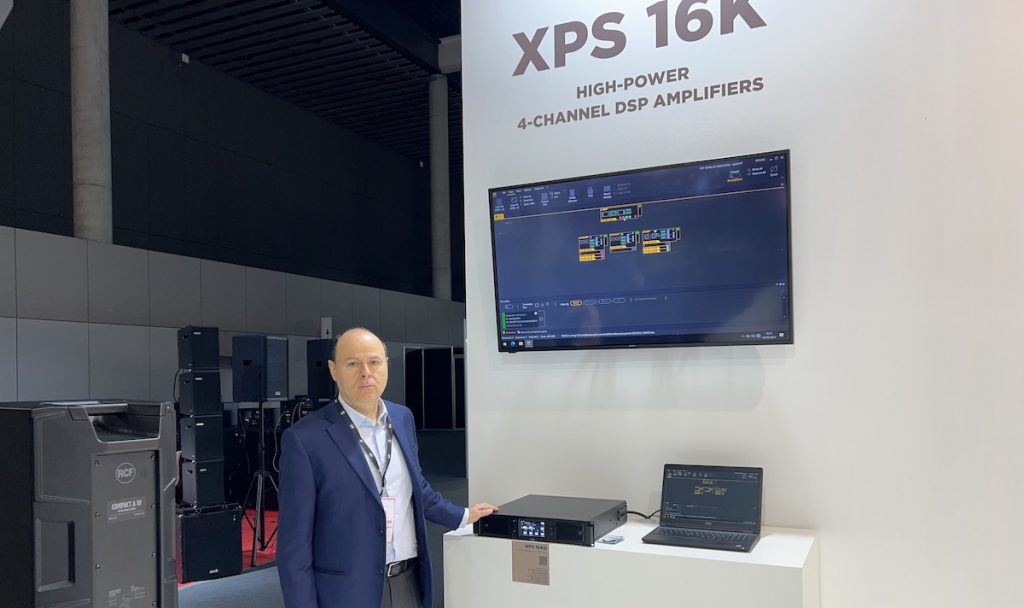Three years after the last edition in Amsterdam, RCF once again took the stage at ISE with several proposals and a special focus on passive amplification.
The first sophisticated audio innovation presented by RCF is “passive” in nature and is called the XPS 16K. A high-power amplifier equipped with an equally powerful digital front-end. Antonio Ferrari, Director of Engineering Support Group, Market Manager Audio Contractor at RCF, tells us about it as he welcomes us to the ISE 2023 booth. “The solution stems from RCF’s experience and know-how in the world of active, multi-amplified and processed loudspeakers,” he explains. “The technology of the XPS 16K model allows professionals to control passive speakers in the same way as active ones, with complete monitoring of the entire system, in perfect accordance with the philosophy of the RCF-branded audio experience. Even in cases where active and passive speakers coexist, the system can now be managed through the single RDNet control platform.”
In technical details, the XPS 16K amplifier offers 4 continuous 4000W power outputs, 4 assignable inputs, analog and digital AES/EBU connections, Dante Audio Networking (in the XPS 16KD version) and a complete set of tools for signal processing and optimization. Thanks to integration with RDNet software, precisely, any sound system manager can choose whether to integrate RCF active, amplified speakers with XPS 16K or in a hybrid configuration. Ideal for high-power installations such as stadiums, arenas, auditoriums, clubs, performance venues and theme parks, the XPS series is easily combined with passive RCF systems through ready-to-use presets combined with other installation-specific features such as advanced system status monitoring, GPIO for extended functionality and flexible routing.

Antonio Ferrari, Technical Support Group Director, Market Manager Audio Contractor of RCF, at the Ise 2023 booth
Also in the rich Barcelona offering were two other releases, concerning more “traditional” RCF amplifiers, namely the IPS series and the QPS series. The latter consists of two four-channel models: one with 10,000 watts (4 x 2500 @ 2 Ohm) and one with 6,000 watts (4 x 1500 @ 2 Ohm) in rated power. The revamped QPS series thus offers Class HD amplifiers equipped with independent gain control for each channel, signal/clip and fault indicators, XLR inputs and outputs, stereo/parallel/bridge operation, and speakON output connectors. In contrast, the IPS series, an entry level with guaranteed performance, includes 2U rack-mount amplifiers for the installation sector, with a Class H topology that can be used in stereo, parallel or bridge configuration, and three power options: 2 x 2600 W (IPS 5.0K), 2 x 1250 W (IPS 2.5K) and 2 x 750 W (IPS 1.5K) at 4 ohms. High quality, low-distortion audio output, speakON standard connectors, and binding posts make the IPS series ideal for many fixed applications. “In terms of segment and applications, we can say that the XPS is suitable for directly driving high-power, high-performance loudspeakers such as the Compact C series, HL and HLVL arrays; the IPS and QPS ranges, on the other hand, need to be complemented by separate processing, using DX series processors, for example.”
On the subject of loudspeakers, here is the innovative ART 9-AX series of 2,100 W bi-amplified portable speakers. In fact, ART 9-AX combines a high-powered two-way active loudspeaker with a 6-channel digital mixer, built-in Bluetooth and advanced control features. All parameters are controllable from the rear panel, via a capacitive color touch screen with knob controller, or through the dedicated app on iOS and Android devices. Equally interesting, the Compact A series with 10-, 12-, and 15-inch passive models. This two-way full-range loudspeaker, made of sturdy and lightweight composite material, is ideal for high-power fixed installation, also for its price-performance ratio. Its design and compactness also make it suitable for any environment, from nightclubs to corporate spaces. Our overview, while not representative of all the technologies on display at the RCF booth, concludes with the Compact C. 12- and 15-inch passive two-way loudspeaker solutions for short- and medium-range applications, which integrate two high-performance transducers ensuring impactful vocal and musical reproduction. The birch plywood cabinet houses RCF Precision neodymium transducers and a 100° x 50° rotatable constant directivity horn. Directivity can be changed to 100°x25° or 60°x25° by applying the accessories in the optional kit. Suitable for sports facilities, clubs, and auditoriums, they can be installed either horizontally or vertically, making use of the numerous wall or ceiling mounting accessories available in the catalog.
In addition, the components for Business Music systems have been enriched with the DMA 504 amplifier, thus also offering a 4-channel medium-power solution (4x500W continuous) again with a digital front-end alongside DMA 82 (2x80W), DMA 162 and DMA 162P (2x160W) and the other Business Music devices. Configurable and controllable via RDNet, it allows Business Music series speakers, Compact-M and others to be driven by recalling their optimization pre-sets. Optional Dante and B.T. cards: the latter also allows control via the DMA-Connect App.
The final comment, on the fair and the market, is up to Gioia Molinari, Director of Marketing and PR at RCF: “We have staked a lot on this return to ISE in its “natural” location of February, ideal for presenting new solutions and launching the design sprint of our professional interlocutors on the current year. In addition, the relocation of the fair to Barcelona seemed to us to be opportune and ameliorative, with the certainty that the details of this certainly not easy operation will also be adjusted in future editions.” For RCF, then, it is an important ISE. “After a 2022 of growth, despite component procurement difficulties and economic tensions, we are ready to raise the bar with increasingly challenging and innovative projects. The technologies are there and support all application segments with different proposals, covering every audio-related need with extreme versatility,” Gioia Molinari concludes.







